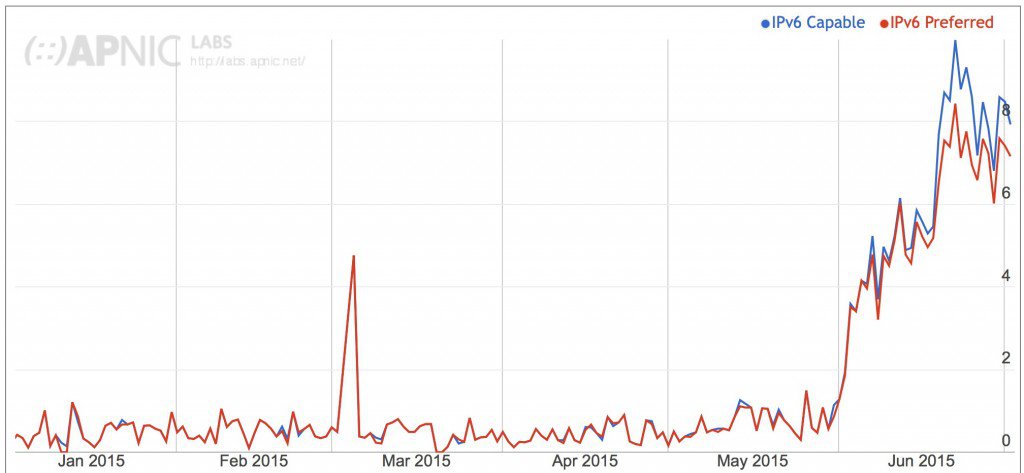Filter by topic and date
Sudden Changes and IPv6 for Everyone
- Jari Arkko IETF Chair
5 Jul 2015
Earlier this week, I was sitting on a train ride through Finland. As usual, my iPad acted as a mobile broadband gateway, and I suddenly realized that my other devices were using IPv6 to reach the Internet through the gateway.

Like many of you, I am a long-time IPv6 user. But now I was on a plain consumer setup: an unmodified iPad, a consumer LTE subscription, a commercial mobile broadband operator, standard laptop… and now these systems had decided to switched on to use IPv6, with no help from me.
And my devices were not alone. In the space of one month the amount of devices that prefer IPv6 connectivity in Finland has gone up from around 0.5% to as high as 8%, and the trend continues. That is a big swing. My story is obviously a personal one, and focused on one country. But similar stories exist for several other places around the world, involving large operators and significant amount of traffic.
The impact of IPv6 may not be immediately obvious to all end-users, but it is significant. First, the use of IPv6 means that Internet traffic goes through end-to-end, with minimal processing in the network. IPv4 NATs stifle the ability of the Internet to evolve and limits innovation. Bypassing those translators with IPv6 leads ultimately to leaner and faster Internet. Secondly, you can address many more devices directly. I saw the effects immediately, as I was now able to reach the sensors and backup servers in my home network directly, without complicated tunnel setups.
Many of us in the IETF have worked on the specifications for IPv6 or built products to support it. But sometimes we are too deep in the bits to notice the big picture. And the many years of development without immediately visible impacts is frustrating. I want to make the observation that large changes in Internet traffic and technology can and do happen. Amara’s Law says that we tend to overestimate the effect of a technology in the short run and underestimate the effect in the long run. Something similar may be happening in this case. Changes are happening, but they are not visible until several things are in place together. A latent capability develops, and when the final pieces fall together, a big swing occurs. In the case of IPv6, popular devices and content are the latent capability that is then suddenly released when network connectivity is put in place. And that seems to be happening for some of the largest operators in the world, such as Verizon Wireless, T-Mobile, AT&T, and Comcast reaching very high numbers in the US. With some of these operators, most of the served users have IPv6 capability.
In the case of Finland, the thanks for making this happen goes to my mobile broadband operator, DNA, who has been one of the leaders of this change in the country. Strangely, while the country has been a technology leader on many fronts, IPv6 deployment here was lagging far behind countries like the US, France, or Belgium. Until this year, when a number of companies and the Finnish communications ministry launched a joint project to change the situation. DNA has been in the forefront of the changes, enabling IPv6 for most of their customers. And without end-user calls to the support line, to boot!
Many end-user devices have had built-in support for IPv6 for some time, and in the last couple of years, content providers such as Google or Facebook have enabled IPv6 in their web presence. This means that when the operator enables IPv6 support, a lot of traffic can immediately switch to using IPv6. A big fraction of the Internet’s traffic is on a few major content providers and content-delivery network operators. As these providers have transitioned, the traffic pattern changes are very sudden. A big part of Finnish IPv6 traffic is from DNA’s customers, but as other operators are also coming online, the numbers keep growing rapidly.
Of course, network equipment manufacturers, user device manufacturers, the IETF, and many others have also done a lot of work. I have been a part of some these efforts in my day job at Ericsson as well as at the IETF, and it is wonderful to see quick growth. While there is a lot of innovation and change in the Internet, many of us have been accustomed to the basic Internet technology changing slowly. But when the right parts come together, the changes can actually be surprisingly dramatic and sudden.
Speaking of evolution of networking, I also noticed that I can get 15x faster connection on mobile broadband than on my DSL. And the sales clerk at the shopping mall was able to say that the new router that I’d need supports IPv6. Nice. I think I’ll be testing this soon.
The future is here, now.
Source of statistics and the graphics: APNIC Labs. An earlier version of this article appeared on the Ericsson Research blog series in here.